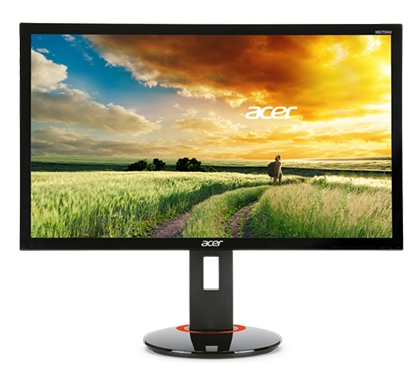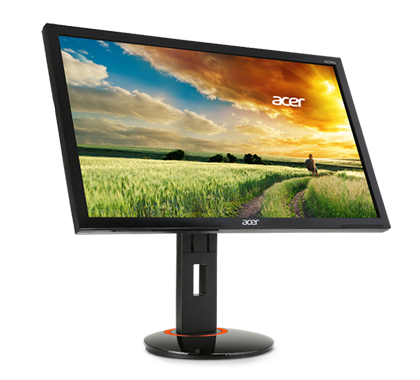Acer Releases XBO Series: 28-inch UHD/4K with G-Sync for $800
by Ian Cutress on September 19, 2014 9:52 AM EST
Monitors are getting exciting. Not only are higher resolution panels becoming more of the norm, but the combination of different panel dimensions and feature sets means that buying the monitor you need for the next 10 years is getting more difficult. Today Acer adds some spice to the mix by announcing pre-orders for the XB280HK – a 28-inch TN monitor with 3840x2160 resolution that also supports NVIDIA’s G-Sync to reduce tearing and stuttering.
Adaptive frame rate technologies are still in the early phases for adoption by the majority of users. AMD’s FreeSync is still a few quarters away from the market, and NVIDIA’s G-Sync requires an add-in card which started off as an interesting, if not expensive, monitor upgrade. Fast forward a couple of months and as you might expect, the best place for G-Sync to go is into some of the more impressive monitor configurations. 4K is becoming a go-to resolution for anyone with deep enough wallets, although some might argue that the 21:9 monitors might be better for gaming immersion at least.
The XB280HK will support 3840x2160 at 60 Hz via DisplayPort 1.2, along with a 1 ms gray-to-gray response time and a fixed frequency up to 144 Hz. The stand will adjust up to 155mm in height with 40º of tilt. There is also 120º of swivel and a full quarter turn of pivot allowing for portrait style implementations. The brightness of the panel is rated at 300 cd/m2, with an 8 bit+HiFRC TN display that has a typical contrast ratio of 1000:1 and 72% NTSC. VESA is also supported at the 100x100mm scale, as well as a USB 3.0 Hub as part of the monitor, although there are no monitor speakers.
The XB280HK is currently available for pre-order in the UK at £500, but will have a US MSRP of $800. Also part of the Acer XBO range is the XB270H, a 27-inch 1920x1080 panel with G-Sync with an MSRP of $600. Expected release date, according to the pre-orders, should be the 3rd of October.
Source: Acer

















57 Comments
View All Comments
Lord of the Bored - Friday, September 19, 2014 - link
Is this still using a FPGA dev board, or does nVidia have an ACTUAL PART to offer monitor manufacturers yet? Because really, I can't take GSync seriously until nVidia is willing or able to make silicon for it.MadMan007 - Friday, September 19, 2014 - link
I don't recall hearing anything about custom silicon, and given the pricing, even as a value-add feature, I would guess there is not any custom silicon yet.There might not be any either if AdaptiveSync becomes the open standard for this type of technology. Then it is more likely it will just become a standard feature of monitors, or at least monitors with the appropriate scalar chips, along with DP 1.3. I am not certain if AdaptiveSync is a requirement for DP 1.3 certification though, or optional.
nathanddrews - Friday, September 19, 2014 - link
Optional for 1.2 and 1.3.Lord of the Bored - Friday, September 19, 2014 - link
Honestly speaking, the strangeness of such a highly-touted feature being implemented in such a haphazard way suggests to me that nVidia was nowhere near ready to unleash GSync to the world and rushed it out in whatever state they could get it into when something forced their hand. Something like an effort to bring VESA adaptive sync to the desktop, just as a random hypothetical example.nathanddrews - Friday, September 19, 2014 - link
The historical record implies that it was the other way around. G-Sync was demonstrated live and had a limited product release before Free-Sync, Adaptive Refresh, or A-Sync were ever mentioned by VESA or AMD.Lord of the Bored - Saturday, September 20, 2014 - link
Which was kind of my point. If they got wind of an effort that was not yet unveiled to the public, they could rush-job a release and steal the glory or ignore it and become known as the guys doing an incompatible re-implementation of someone else's product.Apparently, there are still no actual GSync chips available and they are STILL shipping FPGA prototypes on development boards, a year after the initial "release". That is not the mark of a product that was released last year by a real company. The only people who ship FPGAs are hobbyists making devices that MIGHT sell a thousand units.
nVidia is not a hobbyist working out of a garage. They are a major company with real silicon designers, access to real fabs, enough business volume to make a run of custom silicon cost-effective... and they're shipping FPGAs on a product they launched a year ago. Why?
I am open to alternative explanations for why a major company would conduct business in the manner of a guy in his garage. But I can't explain it without assuming an external factor forced their hand.
nathanddrews - Monday, September 22, 2014 - link
You're making an awful lot of assumptions based upon nothing, really. The reality is that if you want, you can buy and use G-Sync today. You can't use FreeSync.flatrock - Monday, September 22, 2014 - link
"The only people who ship FPGAs are hobbyists making devices that MIGHT sell a thousand units."I've seen a lot of products shipping in higher volumes than a few thousand units using FPGAs.
nVidia might be more interested in licensing the technology to monitor manufacturers that could integrate it into their own chipsets rather than selling ASICs that provide the feature.
Of course they may also be worried that another similar tech will get adopted as the standard, and they would get stuck with a large quantity of ASICs that no one wants to buy. FPGAs are much lower risk.
chizow - Friday, September 19, 2014 - link
Huh? Nvidia developed an ASIC from scratch to do what was not previously available, how does that in any way spell haphazard or unready to launch G-Sync to the world? Do you think FPGAs like this just pop out of holes in the ground overnight?This is in comparison to the competition, which announces a competing solution that doesn't do what they say it does, need to haphazardly force a standard through a notoriously slow standards board, isn't ready to demonstrate their tech for nearly a year after they make the announcement of a competing solution, isn't going to be compatible with the overwhelming majority of their recent products, and won't be available for purchase in actual products until next year.
Gigaplex - Saturday, September 20, 2014 - link
They didn't make an ASIC, they programmed an FPGA. And yes, they can pop up very quickly. That's the whole point of an FPGA.